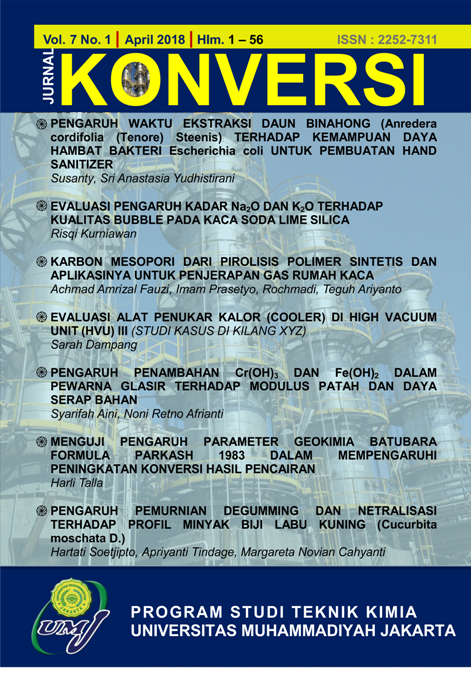PENGARUH PEMURNIAN DEGUMMING DAN NETRALISASI TERHADAP PROFIL MINYAK BIJI LABU KUNING (Cucurbita moschata D.)
Main Article Content
Abstract
ABSTRACTThe objective of the study were to obtain of pumpkin (C. moschata D.) seed oil yield using hexane soxhlet extraction method and the effect of purification on the profile of pumpkin seed oil fatty acids. The results of the study showed that the yield of pumpkin seed crude oil was 37,98% (b/b), whereas the optimum rendement after purification was 76,27% (w/w) by using 0,15% H3PO4. The GC-MS analysis of pumpkin seed oil showed the presence of three same main components of pumpkin seed oil before and after purification which are: linoleic acid, palmitic acid, and stearic acid, respectively. The content of pumpkin seed oil before purification are as follows: 57,96% of linoleic acid, 24,63% of palmitic acid, dan 6,82% of stearic acid, respectively. In the contrary, the content of pumpkin seed oil after purification are as follows: 48,21% of linoleic acid, 20,70% of palmitic acid, dan 5,27% stearic acid, respectively. The purification processes do not affect on the main components of pumpkin seed oil, but determine the difference percentages of pumpkin seed oil main components.
Article Details
Issue
Section
Articles
Authors who publish with this journal agree to the following terms:
- Authors retain copyright and grant the journal right of first publication with the work simultaneously licensed under a Creative Commons Attribution License that allows others to share the work with an acknowledgement of the work's authorship and initial publication in this journal.
- Authors are able to enter into separate, additional contractual arrangements for the non-exclusive distribution of the journal's published version of the work (e.g., post it to an institutional repository or publish it in a book), with an acknowledgement of its initial publication in this journal.
- Authors are permitted and encouraged to post their work online (e.g., in institutional repositories or on their website) prior to and during the submission process, as it can lead to productive exchanges, as well as earlier and greater citation of published work (See The Effect of Open Access).
